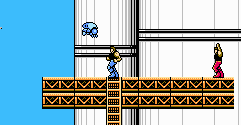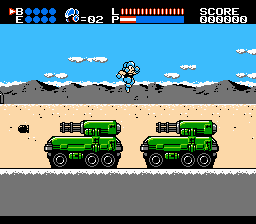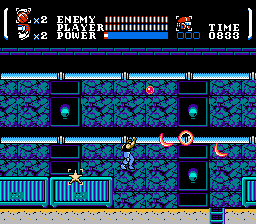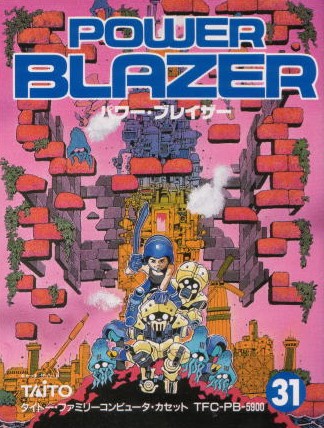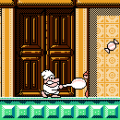- Power Blade / Power Blazer
- Power Blade 2
There are well over a thousand video games released on the Famicom, and only a fraction of them were ever actually translated into English and released outside of Japan. There are any number of reasons, but one of the biggest is simply that many just weren’t any good. Most of the time, these games were simply passed over for localization. But in extremely rare cases, the publisher looked at the title, and felt that it could be done and done better with some re-working. That is the case with Taito, and their two titles, Power Blazer and Power Blade.
In Power Blade, the stubby Mega Man-esque robot was replaced with a beefy Arnold Schwarzenegger clone. The levels were redesigned and expanded to include branching paths. All of the controls were tightened up. There were numerous games in the 8-bit era that got graphical changes to hide their Japanese origins or licenses – Dragon Ball became Dragon Power, Gegege no Kitarou became Ninja Kid, Hokuto no Ken for the Master System became Black Belt, etc. – but this was essentially a whole new game designed specifically for the tastes of the American audience. As such, America (and Europe) lucked out with the vastly superior game.
It almost never came to be, too – according to the guy behind Power Blade, the Japanese bosses were irked that the Americans would have such gall to redesign their (not so) brilliant game, and nearly cancelled it. Thankfully, it made its way to market anyway, earned a Nintendo Power cover, and went on to become a success. And yet, for some reason, Power Blade isn’t really remembered as one of the stand-out classics of the NES, despite its quality. Perhaps it was due to its late release – it came out in 1991, just a few months before the SNES – but it’s definitely a quality game that deserves to be recognized.
Power Blazer (パワー・ブレイザー) – Famicom (1990)
Much like Mega Man, Power Blazer begins with a level select screen. However, the order which you approach the stages doesn’t matter, because you don’t get any bonuses after beating a particular stage. Your hero is a stumpy little midget robot named Steve Treiber, who wields a boomerang. By default, the boomerang’s distance is extremely limited. However, by collecting power-ups, you can toss it farther. This is dictated by a power meter at the time of the screen – the more power you have, the farther it will travel. Which each toss, however, the power meter empties, and you need to wait another second or two for it to refill. You can still attack, but your boomerang won’t travel as far.
It’s an interesting concept that’s mimicked similarly in other games like Astyanax and The Legendary Axe, since you can’t just spam the attack button and expect to get results. Unfortunately, it doesn’t quite work here, just because the enemies are so overpowered. The game is full of bad guys which will hop right up in your face, and since it takes so long to charge up your boomerang, you’re forced to take them on in extremely close quarters. Most foes take several hits too, obviously including the boss monsters, which is all the more aggravating. Plus, whenever you hit something with your boomerang, it will automatically reflect back, only registering a single hit. You can cheat a little by overshooting your foe, and the boomerang will hit several times as it flies back to you. Or, you can hope for the power-up which will cut through enemies and allow your boomerang to hit multiple times in a single throw. These little tricks help the frustration a little bit, but it’s still annoying.
Even worse, though, are the controls. Your hero walks slowly and can barely jump, which leads to lots of annoying platforming deaths if your leaps aren’t pixel perfect. There are some other bonus items to find, like bombs and energy tanks – these can be used at any time to kill everything on the screen or regain some health, respectively, and they do help balance out some of the annoyance. Although there are only seven stages, there’s a password system that will help you get through the game quickly.
Power Blazer has the foundation for a decent game – the graphics are nice, and all of the music is incredibly catchy, easily rivaling Konami’s better NES games. It makes total sense that it was composed by Kinuyo Yamashita, who was also behind the immensely classic soundtrack to Castlevania. But the annoyances end up dragging the game down severely.
Power Blade – NES (1991)
Power Blade is such a huge improvement over Power Blazer that it’s not even funny. Other than the change from a stumpy robot to a muscular dude with a buzz cut named Nova, the graphical style is pretty much identical, in some cases reusing some of the same background tiles. Most of the enemies are the same, although there are a few new ones. Most of the bosses are identical too, although some of the goofier ones – the Frankenstein monster in particular – have been redesigned and revised. All of the awesome music is identical, although there are a few new songs for the intro and ending. Speaking of which, there’s a new intro cinema, and the few other cutscenes have been entirely modified to be a bit less cartoony. There’s now an enemy life meter for when you fight bosses, and the level select screen is actually nice enough to tell you which stages you’ve already completed.
All of the level designs are completely new, and here lies one of Power Blade‘s biggest alterations. The stages in Power Blazer were completely straightforward, but Power Blade allows for much more exploration. Most stages have branching paths and extra rooms to explore, most of which contain power-ups. Additionally, you need to hunt down an informant in each stage, which will allow you to open up the boss door at the end of the level. On one hand, this gives a slightly more open-ended feel than most NES action games. On the other hand, it’s a bit frustrating to get to the end, only to realize that you missed the informant or took the wrong path…or even worse, if you loop around back to the beginning of the stage. Still, these are only annoyances the first time you play, and the stages are never so confusing that you’ll get lost. There is a time limit, but unless you’re playing on the Expert difficulty level, it won’t prove to be an issue.
The basic mechanics of the game have completely removed almost everything annoying from its predecessor. For starters, you run much faster, jump much farther, and your boomerang power meter regenerates much quicker. Your boomerangs will always carve through foes, scoring multiple hits, so you don’t need a power-up. You can still find items that increase its strength, but there are also items that will allow you to throw multiple boomerangs at once, wherein you could only throw one in Power Blazer. Your attacks have also been made more versatile, as you can throw your boomerang in any direction. The energy tanks and bombs return, but you can also find a power suit, which encases your hero in armor. When equipped, it will allow you to shoot out extremely damaging energy waves, and also shields you from three hits before it disintegrates.
The only minor problem? In the process of making Power Blade totally awesome, they also made it much, much easier. You’re so overpowered that can generally blow through all seven stages without much of a problem. Similarly, the bosses that proved immensely annoying in Power Blazer are now a total joke in Power Blade, even though they’re exactly the same. To balance this out, there’s now an additional Expert mode, although it barely makes the game any more difficult. Still, even if it won’t challenge you in the way Castlevania or Ninja Gaiden will, it’s definitely an unsung classic amongst NES games.
Screenshot Comparisons

